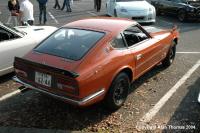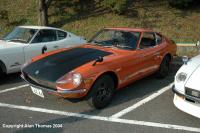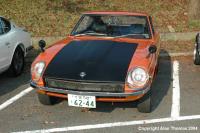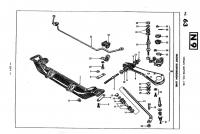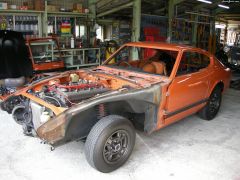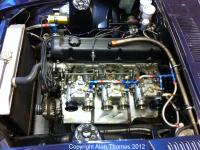Everything posted by HS30-H
-
Genuine PS30-SB 'Fairlady Z432-R' refresh story in Gallery
I wish! There's a caveat to that "all built in one batch" statement as it may be the case that a few more were built a little later. I'm thinking of slightly later circuit race cars, and some of the Works rally 240Zs here. The majority of the Works rally 240Zs built in 1970 and 1971 ( before the rule changes for the 1972 season led to Nissan reverting to the 'full fat' bodyshells ) were essentially 432-R bodies with L24 engines. They carried series-production HS30 and HLS30 chassis numbers and they didn't count as actual PZRs, but the 'shells were hybrid versions of the lightweight PZR spec. I think I might be causing some confusion with some of the factory shorthand terms I've been using, so I'll just clarify: 'PZ' = PS30 Fairlady Z432 'PZR' = PS30-SB Fairlady Z432-R The 'ordinary' PZ body was in most areas similar or the same as the L-series variants made alongside it during the same period ( apart from all those S20-engine and ancillary specific brackets, tabs, captive nuts and screw holes ), but the super-lightweight PZR body was radically different in its very fabric. It wasn't just about the special parts that were ( and were not ) hung on that body tub, but about 'Part Number One' - the body tub itself - being special. I really want to get that point across. Cheers, Alan T.
-
Genuine PS30-SB 'Fairlady Z432-R' refresh story in Gallery
The story is that all of the super lightweight 432-R bodyshells were made in a single batch, and then put aside to be given a chassis number and put through final assembly as-and-when they were ordered. The sequencing of their chassis numbers certainly seems to support this. Most of the PZRs sold to the general public would - I think - have been made during 1969 and 1970, and the majority well before the end of 1970. The "Series 1 " and "Series 2" thing is a retrospective moniker that applies more to the north American market cars and I'm more than wary of applying it to the Japanese market cars ( where small incremental changes seem to have been made in between bigger updates ). Suffice to say that we should probably expect the vast majority of PZRs to have '69 & '70 production dates. I'm not aware of any 432-R chassis numbers over PS30-00300 ( remembering that they shared their 'PS30' prefix with the 'ordinary' 432 ), and according to Nissan less than 30 true PZRs were made anyway. Officially, less than 20 PZRs were sold to the general public for private road use and the rest were race cars. So even if the "Series 2" soubriquet could be applied to the PZR it would probably be moot as it was all done and dusted by the end of 1970. Officially, anyway. I should by now have learned never to say never with respect to the 432-R. I think I probably ought to bring up the race homologation aspect to all this, as it kind of explains some of the numbers and the PZR's relationship with the PZ. Watch this space.....
-
HLS30 00008 Hot Wheels to be released
Point of order: If we are talking 'Datsun 240Z' and concentrating purely on "lowest VIN released for sale to the public", then the RHD HS30-prefixed 'Datsun 240Z' export market variants would be in with a good shout to claim the low VIN bingo prize: HS30-00003, HS30-00004, HS30-00005, HS30-00006, HS30-00007, HS30-00008, HS30-00009, HS30-00010, HS30-00011, HS30-00012 and HS30-00013 were all - according to Nissan - sold to the general public. I've seen the VIN tag ( and firewall-engraved chassis number ) of HS30-00013 hanging on the notice board of a friend's garage.... S30 and PS30-prefixed chassis numbers lower than 00013 were also sold to the general public in Japan. S30-00002 was almost certainly a factory 'mule' of some sort, used for testing / experimentation / instruction, and never originally intended to be sold to the general public. I can't help thinking that this Canadian "extended cold weather testing" thing was actually the 'Kaku-U' North American 'test' ( publicity tour ) itself, and not another trip based on it or an extension of the original trip. Is it not more likely that the two things are one and the same? It seems to make more sense to me. First of all, it was a bit late in the day to be doing any real testing ( this would have been late 1969, and the start of production was already underway ) and Nissan had already been conducting extended cold weather tests up in Hokkaido, Japan. It's not like Japan is short of cold weather in the winter months....
-
Genuine PS30-SB 'Fairlady Z432-R' refresh story in Gallery
Hi Carl, Thanks for that. I'm a huge fan of the homologation specials and the Works race and rally cars, and I think we are very lucky to see the images that Takeuchi san is showing us. Most of the Rs live well out of the limelight these days, and Takeuchi san is giving us a rare and candid look at his. Manna from heaven for me. Hi Kats, I assure you it's true. However, it's hard to prove without completely cutting one up...... One of the things I love about these homologation specials is that they are the gift that keeps on giving. There's always some new fact to learn, and some new question to ask. Each car seems to have its own specification. They are so mysterious. I love it! Cheers, Alan T.
-
Genuine PS30-SB 'Fairlady Z432-R' refresh story in Gallery
Just to clarify, Takeuchi san's car is a PS30-SB 'Fairlady Z432-R. It's not a 'normal' Fairlady Z432, it's even more special. I tried to list most of the differences between a 'normal' Z432 and a genuine Z432-R in post #8 on this thread. It's not a definitive list, but it does address many of the things that made the 'R' special even in comparison to the Z432. First and foremost among them is the 'super lightweight' bodyshell... Yes, the 432-Rs didn't have brake boosters. This saved some weight ( very important with regard to the homologation of the model ), but also gave better brake 'feel'. The pedal effort required would have been higher than a boosted system, but this was offset by the fact that the 432-R had a different brake pedal to the boosted brake cars. The amount of leverage given by the pedal was increased, as the pivot point was different in comparison to the boosted cars.
-
Genuine PS30-SB 'Fairlady Z432-R' refresh story in Gallery
No problem, Takeuchi san. Every picture is worth a thousand words! Kats and myself can help with explanation / translation if necessary. Cheers, Alan T.
-
Genuine PS30-SB 'Fairlady Z432-R' refresh story in Gallery
A couple of things that I forgot to include in my description of 'showroom stock' 432-R specifications: You would not see any stainless garnish in the windscreen / tailgate rubbers. The rubbers were the same as 'stock' on other cars, but they simply did not put the garnish into the rubber on assembly. Same with the roof gutters: No stainless garnish along the roof gutters in the standard specification of the 432-R.
-
Genuine PS30-SB 'Fairlady Z432-R' refresh story in Gallery
Hi Kats, I believe that the PZR-specific panel pressings were made from one gauge thinner sheet steel than the other early S30-series Z models. There are also some sections of the bodyshell ( inner sills / rocker panels, and around the diff area ) which are one gauge thicker than on 'normal' cars, but maybe this was not on all 432-Rs. The variation in panel thickness is - I think - part of the result of the manufacturing process. Some areas of the panels stretch, and some are forced to shrink in the dies. I have seen and measured this variation on stock bodyshells too. Yes, received safely. Thank you! I have sent you an e-mail. Cheers, Alan T.
-
Genuine PS30-SB 'Fairlady Z432-R' refresh story in Gallery
Hi Chris, As far as I am aware, the stock 432-R would not have had any underside protection apart from body colour overspray over the stock primer. I think Takeuchi san's car was possibly protected later? But each car must be viewed on a case-by-case basis. There seems to have been an exception for every rule. In the case of underbody protection, I should think the territory the car was going to would influence the spec. If it was going up to snowy Hokkaido, for instance... Alan T.
-
Genuine PS30-SB 'Fairlady Z432-R' refresh story in Gallery
Hi Marty, If you saw a Fairlady Z432-R in a Nissan showroom in 1970, you'd be able to recognise it from the following: First of all you'd probably see a 918 Orange paint job, as all the 432Rs sold to the general public were apparently in the one no-option colour. Next you'd notice the anti-glare satin black FRP bonnet / hood, and the smooth all-chrome bumpers with no rubber trims and no trim holes. You should see plain steel wheels with no hubcaps ( the magnesium Kobe Seiko wheels standard on the 432 were an extra-cost option on the 432-R ) and a plain clear glass, untinted, windscreen / windshield. You should also see a satin black FRP rear spoiler - the ribbed type ( for extra sensitivity... ) - sitting on the tailgate. No badging other than 'Fairlady Z' and '432' ( and perhaps an oblong 'Nissan' emblem on the rear spoiler ), and there was no 'R' type badging or emblems. A side stripe kit might have been fitted. Look a little closer and you'd see that the door window, quarter and tailgate glass was actually lightweight acrylic with a 'Nissan' heatstamped logo in the corners. Some - but perhaps not all - 432Rs had an FRP tailgate, with no gas strut ( just a steel rod prop ). Look around underneath and you'd see a full-length FRP undercover for the engine bay at the front ( the front valance subtly shaped, and with captive nuts, to accommodate it ), and the 100 litre fuel tank in the rear ( to homologate the 100 litre tank for JAF-sanctioned GT class endurance racing ). The front grille should be subtly different to the standard Fairlady Z / Z-L / 432 item, with a finer mesh. Peering inside, you would see the spare wheel perched on the rear deck area ( the spare wheel well having been deleted to make way for that 100 litre fuel tank ) and a pair of hopsack weave fabric-covered FRP bucket seats ( manufactured by office furniture maker Ikeda Bussan ), and probably only the driver's seat would have a bolt-on headrest with a black vinyl cover. You should also see a Takata four-point safety harness on each seat. Had the new owner specified it - and paid the extra cost - a leather-covered 'Mach' three spoke steering wheel might be present, but if not then the standard Izumi pressure-moulded wood composite wheel. The plain black moulded urethane / rubber mats on the floor would sit on plain painted metal with no sound-deadening material on it. The diamond quilted vinyl interior covering - as seen on other S30-series models of the same period - would have no sound-deadening / insulating material under it either, although the trans tunnel cover would be plain unquilted vinyl. A thin urethane / rubber mat would sit on the rear cargo area. The firewall should have no sound-deadening mat on it either. The dash would look a bit bare, as stock 432-Rs had a blanking plate in place of the clock. Standard 432-Rs would often have no glovebox lid and no heater / fan - although some buyers paid extra for them to be fitted. Proper 432-Rs would have no radio and no antenna. You'd see just one sunvisor ( for the driver ) and no day/night feature for the rear-view mirror, and no centre console. There would be no ignition key barrel on the steering column, as it was re-located to a bracket just in front of the gearstick ( to make it easier to reach when strapped in by the four-point safety harness ). Door panels should have simple woven nylon pull straps instead of arm rest / door pulls. Looking in the engine bay, you should see no air box on the Mikuni 40PHH carbs ( just steel trumpets ) and no air filter box on the radiator support panel. You'd see an oil cooler standing in front of the ( aluminium ) radiator. You should see no brake booster either, as it was deleted to save weight and give better pedal feel through a brake pedal with a different pivot ratio to other models. You would not be able to see those lightweight body pressings ( made from one gauge thinner steel than stock ) but they'd be there. Apart from all that, it would be the same as the PS30 Fairlady Z432 standing next to it in the showroom... That's the theory anyway. In practice it seems that there was some subtle variation in specs, and that buyers either specced the cars with a few extras ( heater / demister, glovebox, mag wheels ) or added them soon after buying. Many cars will have been modified down the years ( one 432-R even ended up with a G-nose... ) but the trend these days is to bring them back to a period-correct spec. I'm sure to have forgotten something, but that's all I can think of off the top of my head. I find the cars fascinating, and I'm always learning new things about them. Cheers, Alan T.
-
Genuine PS30-SB 'Fairlady Z432-R' refresh story in Gallery
If you have a few minutes to spare, please take a look at our fellow forum member take432r's Gallery photos: take432r Gallery - Classic Zcar Club Photo Gallery 'take432r' is Takeuchi san from Japan, and his genuine PS30-SB 'Fairlady Z432-R' has been the star of many Japanese classic car magazine features. Takeuchi san has been refreshing the car recently, and has been adding some very interesting and informative photos to the above gallery. Please take the time to have a look at them, as they reveal many of the 432-R's subtle differences from the 'normal' 432, and of course all other S30-series Z cars. It's a rare treat to see a genuine 432-R in pieces... The 'super lightweight' PS30-SB is the rarest of S30-series production models, and certainly the most valuable today. 'Less Is More' certainly applies here, and the 'PZR' ( in factory jargon ) hides many of its unique features - such as its super-lightweight body with thinner gauge panel pressings, whilst many others are not immediately apparent - such as its acrylic windows and 100 litre fuel tank, until you start looking a little more closely. I've seen this car in the metal ( and plastic! ) several times in Japan, and it's one of the few S30-series Zs that I seriously covet. It's lovely. Cheers, Alan T.
-
Zcon 2013
I'm talking about the C30-series Laurel, of course. If you really want to comb through and look for clues ( it's fun! ), I can send you the factory parts manual for the C30 as a PDF.... But my point is that it's daft to call the "350/370 Z Car" ( Z33 / Z34 actually.... ) a "shortened Infiniti" if you still think the ( shout it ) "DATSUN 240Z" is some kind of virgin-pure engineering Year Zero creation and you have little or no idea about the cars that were alongside it in the design / drawing offices or on the production line, let alone alongside it on the showroom floor. Platform sharing is the modern way. It doesn't make the Z33 or Z34 any less of a car. Here's a peek at one page from the 1968 C30 Laurel parts manual. This one's a well-known engineering design share:
-
432R is beautiful; but
-
Reproduction S30 parts NLA.......
Perhaps a reminder of the thread title and the following quote from the first post is in order: The S30 is not all about the "DATSUN 240Z", however loud you shout it.... Japanese market S30-series Z threshold plates ( 'PLATE - kicking, sill outer' ) had no lettering on them whatsoever, and they certainly qualify for this thread.
-
Zcon 2013
....whilst you're still in denial that you own a Laurel Sport.
-
Nuts and Bolts What to do?
I'd rather trust Nissan, thanks. As has been discussed so many times before on this forum, there's almost nothing on the early Z cars that was Cadmium plated. Almost everything that was plated was Zinc plated, and the characteristic 'yellow gold' of many nuts, bolts fasteners, brackets and other nick-nacks is simply a passivated finish added after Zinc plating. From Nissan technical manuals: 亜鉛 ( 'A-en' ) = Zinc.
-
Reproduction labels?
No offence to you or the vendor, but I would suggest that unless you are dealing direct with Nishi san from 'Revive Jalopy' in Japan then your 'vendor' is very unlikely to have been dealing with the OEM material manufacturer / supplier. One observation I would make is that I've seen both gold and silver backgrounds on Nissan maintenance stickers, depending on the application and period of manufacture. I've also seen all sorts of patination / discolouration which - over a 40 year odd period - can make such stickers look very different to how they must have looked when new. I would trust MikeB's example for the manufacture date period he has shown.
-
Let's show vintage racing pictures. I'll start.
It's not a GTP car. It's an R90CK ( Lola chassis ) with the VRH35Z V8 turbo engine from the 1990 Le Mans 24hrs. Specifically, the JECS 'sponsored' #25 car of Donnelly / Brancatelli / Acheson. It had qualified 5th, but DNF'd due to terminal transmission trouble.
-
Let's show vintage racing pictures. I'll start.
Yeah. Maybe it's in Japan too...? He's got me on his 'Ignore' list, obviously.
-
Let's show vintage racing pictures. I'll start.
It's actually a works PA10 Violet on the 1980 East African Safari Rally. Specifically, the no.10 car of Rauno Aaltonen and Lofty Drews, which finished in second place behind the sister no.1 car of Shekhar Mehta and Mike Doughty.
-
Let's show vintage racing pictures. I'll start.
Well, many of the images you've been posting have obviously been right-clicked-and-saved from elsewhere. So this guy is simply getting them from the internet ( I can tell you that he most certainly does NOT own the copyright to the many of them ) and is putting them on the picture-only thread that you're sourcing them from, but divorced from their original source and context. What a waste. So where is this mystery forum and mystery thread you're getting them from? Is there no conversation about car, driver, event, date, photographer whatsoever....? Is it just eye candy....?
-
Let's show vintage racing pictures. I'll start.
Only if you count 1976 as "recent". That's the car that Andre Haller died in whilst competing in the 1976 Le Mans 24hrs race. We've discussed it several times on this forum in the past. How come you're 'finding' just so many photos that you don't seem to know anything about? Don't any of your sources list the relevant data? If not, why not? Is it because they are just endlessly right-clicking-and-saving and then re-posting elsewhere without taking any notice of the context? It's as though pages are being torn out of books, thrown on a big pile and then reassembled in random order.
-
How Many 260Z's built in 1973?
How about considering the effects on supply before demand? The 1973 Arab-Israeli 'Yom Kippur War' and the OPEC oil embargo that followed it caused huge disruption in Japanese manufacturing and the Japanese economy as a whole. As Japan imported all of its oil, the embargo had massive implications for Japanese industry. That period became known as the 'Oil Shock' in Japan, and its effects lasted for many years beyond the initial events. Looks like we have the beginnings of a similar situation in the same region again today....
-
Key differences between the American and European 260z
There are misconceptions about everything, though. Try telling people that "240Z" means more than one thing and they look at you funny. Same with "260Z". There's '260Zs' and there's '260Zs'.... There certainly were basic power differences for what appeared to be similar engines, depending on the period and the market. It may not be as much as the OP hoped - or as little as you think - but for sure there were differences in camshafts, compression ratios, ignition timing / timing curves and carburation, and that's before we start talking about any anti-pollution gear being hung on them. Like-for-like, year-for-year, I think you'll find that the 'Euro' market models will always have had more power than north American market models. Maybe not much, but worth noting.
-
Let's show vintage racing pictures. I'll start.
That's the old Fourways Engineering 'Bluezmobile' Modsports racer, here in the UK. Now in new ownership, but Fourways are still involved in prepping / running it. Many of the panels are alloy, and it has some interesting mods. Fast car. How come you seem to find so many photos that have been separated from their original source?





